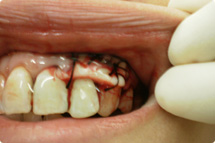Periodontal disease is mainly caused by bacterial plaque. Plaque is the sticky, colourless substance that forms on your teeth. Other factors that also affect gum health include:
- Smoking
- Poor nutrition
- Stress
- Genetics
- Medications
- Diabetes


What are the dangers of periodontal disease?
Periodantal disease is the leading cause of tooth loss among adults. More importantly, the infection releases toxins into the blood stream leading to serious health risks:
- Stroke
- Heart disease
- Diabetes
- Spontaneous preterm births

Periodontal (gum) diseases, including gingivitis and periodontitis, are serious infections that, if left untreated, can lead to tooth loss. The word periodontal literally means "around the tooth." Periodontal disease is a chronic bacterial infection that affects the gums and bone supporting the teeth. Periodontal disease can affect one tooth or many teeth. It begins when the bacteria in plaque (the sticky, colorless film that constantly forms on your teeth) causes the gums to become inflamed.
Root Planing
Root planing is a non-surgical therapy to treat gum disease. By carefully cleaning the root surfaces of the tooth and deep pockets around the tooth, plaque, calculus and bacterial toxins are removed. This process is usually repeated over time until the health of the gums is restored. In some cases, the therapy will be combined with antibiotics. This therapy may be repeated to maintain the health of the gums.
Gum Surgery
In some cases, root planing alone cannot completely resolve the gum disease. Further treatment that involve surgical procedure to the gums will be required to restore the damaged gum area. Once restored, a patient will be able to maintain the health of the gums through good oral hygiene practices.



Tissue Grafting
Soft tissue grafting is often done for cosmetic purposes ie. to improve a smile by correcting the gum lines or lenghtening the tooth by reducing the gum lines.
However, in periodontal treatment, soft tissue grafting can improve damaged tissue areas as well as prevent the development of periodontal diseases.
Lost tissues and receded gums due to periodontal disease or overbrushing may lead to the exposure of teeth roots. A soft tissue grafting will improve these conditions and help prevent additional recession and bone loss.


Periodontal disease is mainly caused by bacterial plaque. Plaque is the sticky, colourless substance that forms on your teeth. Other factors that also affect gum health include:
What are the dangers of periodontal disease?
Periodantal disease is the leading cause of tooth loss among adults. More importantly, the infection releases toxins into the blood stream leading to serious health risks:
Periodontal (gum) diseases, including gingivitis and periodontitis, are serious infections that, if left untreated, can lead to tooth loss. The word periodontal literally means "around the tooth." Periodontal disease is a chronic bacterial infection that affects the gums and bone supporting the teeth. Periodontal disease can affect one tooth or many teeth. It begins when the bacteria in plaque (the sticky, colorless film that constantly forms on your teeth) causes the gums to become inflamed.
Root Planing
Root planing is a non-surgical therapy to treat gum disease. By carefully cleaning the root surfaces of the tooth and deep pockets around the tooth, plaque, calculus and bacterial toxins are removed. This process is usually repeated over time until the health of the gums is restored. In some cases, the therapy will be combined with antibiotics. This therapy may be repeated to maintain the health of the gums.
Gum Surgery
In some cases, root planing alone cannot completely resolve the gum disease. Further treatment that involve surgical procedure to the gums will be required to restore the damaged gum area. Once restored, a patient will be able to maintain the health of the gums through good oral hygiene practices.
Tissue Grafting
Soft tissue grafting is often done for cosmetic purposes ie. to improve a smile by correcting the gum lines or lenghtening the tooth by reducing the gum lines.
However, in periodontal treatment, soft tissue grafting can improve damaged tissue areas as well as prevent the development of periodontal diseases.
Lost tissues and receded gums due to periodontal disease or overbrushing may lead to the exposure of teeth roots. A soft tissue grafting will improve these conditions and help prevent additional recession and bone loss.